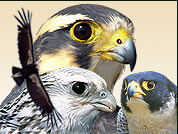|
| Researchers are invited to send requests for assistance to grin@peregrinefund.org for posting here |
|
Grey Falcon records
Observation records of the Grey Falcon from any part of its Australian range are requested by Jonny Schoenjahn (phone 9385-9939; jonnybird@bigpond.com; www.jonnybird-australia.com/greyfalcon/.htm), who has been compiling information on the status and distribution of this rare species for the past eight years. (Posted on 8 Jan. 2012)
|
Tagged Turkey Vultures
The University of California Davis - Wildlife Health Center began a statewide study in 2008 looking at heavy metal exposure in scavenging birds. Turkey Vulture is one of the species that has been live trapped, tagged, and monitored. The TUVUs are fitted with "large white with black-numbers" patagial (axillary) tags that are easily visible in flight and when perched. Numbers can usually be easily read with binoculars and/or spotting scopes. Please report any sightings with exact location, observer, date, and tag number to the Bird Banding Laboratory at http://www.pwrc . usgs.gov/ bbl/homepage/ reptauxm. htm. Also, please report the sightings to Pete Bloom at PHBloom1@aol.com and Terra Kelly at trkelly@ucdavis.edu.
|
Malta Peregrine Breeding Project
The Malta Falconry Centre is currently completing an application for a Life+ Nature Project (an EU funding scheme that co-financing projects that deal with environmental conservation in its various forms) with the objective of creating a captive breeding programme for the Peregrine Falcon. This is an endemic falcon in the Maltese Islands but it has recently become extinct. The aim of the captive breeding programme is create a sustainable Peregrine population that can be released in the wild. We would like to invite researchers, falconers and captive breeding experts (preferably from EU countries) that are interested in assisting in the various aspects of the captive breeding and releasing programme to contact us on: Fax: 00356 21418702, Tel: 00356 21418756, or email: maria@paragoneurope.eu
In your response kindly specify your area of interest and expertise together with the area or stage of the project on which you would like help us. We would be grateful if you could also forward us your CV.
Thanks in advance for your cooperation! Best regards,
Maria Gatt, Paragon Ltd.
|
Wing-tagged Turkey Vultures in Venezuela
More than 100 North American Turkey Vultures were marked in 2006-2007 on their wintering gounds in Venezuela with red wing-tags with white numbers, or blue wing-tags with black numbers. Sightings of any of the birds along with information on date, location, tag number and color, which wing tagged, and behavior when seen should be reported to Keith Bildstein, Hawk Mountain Sanctuary, at bildstein@hawkmtn.org; 1-570-943-3441, ext. 108.
|
Saskatchewan Vulture Studies
A long-term wing-tagging project with nesting Turkey Vultures in Saskatchewan is continuing, and details of sightings of birds with green tags with white letters or numbers should be reported to C. Stuart Houston at stuart.houston@usask.ca or (306) 244-0742.
|
Alberta Vulture Sightings Needed
A long-term study of nesting Turkey Vultures in east-central and northern Alberta was begun in 2003 by Wayne Nelson, Floyd Kunnas, and Dave Moore of the Alberta Fish and Wildlife Division to investigate the productivity and distribution of these birds. Observers are encouraged to report all sighting of TVs in this region, along with data on date, location, and activity, to Rick Morse at ricmorse@shaw.ca or (780) 405-7389.
|
Northern Harriers
Patagial markers have been placed on Northern Harriers as a part of a long-term study of populations on Whidbey Island and in the Kent Valley, Washington. Report observations of marked birds, including details on tag color, location, and markings to Jack Bettesworth, 2569 12th Ave. W, Seattle, WA 98119, (206) 285-5276 (jgbett@comcast.net).
|
Cooper's Hawk study
Since 1996, color bands have been placed on over 1,200 nestling Cooper's Hawks in Victoria, British Columbia as a part of a long-term study on the urban-nesting ecology of this species. Report sightings of marked birds, including color, date, time, and location, to Andy Stewart, BC Conservation Data Centre, Victoria, BC, (250) 387-9780 (andy.stewart@gems6.gov.bc.ca).
|
Ferruginous and Swainson's Hawks
Color bands were placed on nestling Ferruginous and Swainson's Hawks in the Arlington, Oregon area of the Columbia Basin in Spring 2007 and 2008 as a part of a windpower-funded monitoring project. All chicks were banded in with a unique color band on one leg and a metal band on the other leg. Sightings should be reported to Scott Downes, Northwest Wildlife Consultants, at s.downes@nw-wildlife consultants.com or (509) 833-8331.
|
Coastal raptors
Colored leg bands have been placed on Peregrine Falcons, Gyrfalcons, and Bald Eagles and leg flags placed on Merlins on beaches at Ocean Shores, Grayland, and the Long Beach Peninsula, Washington. Please note band or leg flag code, color, date, time, and location and report sightings to Dan Varland at (360) 591-5959 or danvarland@coastalraptors.org.
|
Accipiter winter site fidelity study
Blue VID bands have been placed on Cooper's Hawks and color and aluminum bands on Sharp-shinned Hawks in Washington. Please note right or left leg and numbers on engraved bands, and report date, time, and location of sightings to Jack Bettesworth, 2569 12th Ave W., Seattle, WA 98119, (206) 285-5276, jgbett@comcast.net.
|
|
|

